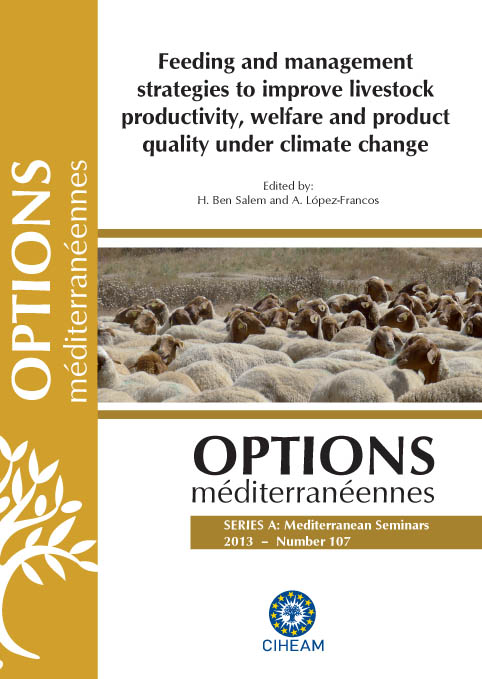| Article précédent | p. 69-75 | Article suivant |
Effect of partial replacement of concentrate with feed blocks including tomato wastes from greenhouse horticulture on methane and milk production and milk composition in goats
The aim of the present work was to study, in dairy goats, the effect of replacing 35% of concentrate in the diet with feed blocks including tomato fruits wastes on CH4 emission, milk yield and fatty acid and amino acid profiles. Eight Granadina goats (39.6 ± 1.89 kg BW) in the middle of the third lactation were used, and a two-periods trial was carried out following a crossover design. In each period, 4 animals randomly received 1.0 kg of alfalfa hay (AH) plus 1 kg of concentrate (diet AC) and the other 4 received 1.0 kg AH plus 0.65 kg of concentrate plus tomato feed blocks ad libitum (diet ACB). The amounts of AH and concentrate supplied to the animals fed diet AC were sufficient to allow daily milk production of up to 2 kg per goat (Aguilera et al., 1990). The feed block was supplied ad libitum resulting in average intakes of 208 ± 31.8 g of DM/animal/d. Each period included 25 d for adaptation to diet and 8 d for sampling the 3 last for CH4 measurement in chambers. The ACB diet resulted in a 38.3% reduction (P = 0.001) in CH4 emissions, and increased (P ≤ 0.048) average proportions of linolenic, linoleic and total polyunsaturated fatty acids in milk. The amino acid profile and concentration were unaffected by diet, but the proportion of phenylalanine was lower (P = 0.039) in ACB milk compared to the control diet. It is concluded that feed blocks based on tomato fruits wastes could replace 35% of the concentrate in dairy goats diet without detrimental effects on milk production and fatty acid or amino acid composition. Overall, diet including tomato feed blocks promoted the production of milk with healthier fatty acid profile and reduced feeding cost and the environmental damage caused by CH4 emissions, compared with a conventional diet.
Ce travail avait pour objectif l'étude, chez des chèvres laitières, du remplacement de 35% de la fraction concentrée de la ration par des blocs alimentaires contenant des sous-produits de tomate sur les émissions de CH4, la production laitière et la composition du lait (acides gras et acides aminés). Huit chèvres de la race Granadina (39,6 ± 1,89 kg poids vif) en milieu de troisième lactation ont participé à deux essais selon un schéma en cross-over. Dans chaque essai, 4 animaux tirés au hasard ont reçu 1,0 kg de foin de luzerne (AH), plus 1 kg de concentré (régime AC), alors que les 4 autres ont reçu 1,0 kg AH plus 0,65 kg de concentrés et des blocs alimentaires contenant des tomates offerts en quantité ad libitum (régime ACB). Le régime ACB a entraîné une réduction de 38,3% (P = 0,001) des émissions de CH4, et une augmentation dans le lait (P ≤ 0,048) des proportions des acides linolénique et linoléique et des acides gras polyinsaturés totaux. Le profil en acides aminés et leur concentration n'ont pas été affectés par le régime, mais la proportion de la phénylalanine a été plus faible (P = 0,039) dans le lait des animaux recevant le régime ACB par rapport au témoin. En conclusion, le régime ACB distribué aux chèvres favorise la production d'un lait avec un profil en acides gras de meilleure valeur nutritionnelle tout en réduisant le coût de l'alimentation et les impacts environnementaux négatifs de la production caprine liés aux émissions de méthane.
- [ Afficher ]
- [ Télécharger ]
- [ Exporter la citation ]
Vous pouvez télécharger la citation au format :
- [ Imprimer ]
-
Mots-clés
ACIDE AMINE, ACIDE GRAS, CAPRIN, FEEDLOT, LAIT, METHANE, TOMATECiter cet article
Romero-Huelva M., Ramos-Morales E., Molina-Alcaide E. Effect of partial replacement of concentrate with feed blocks including tomato wastes from greenhouse horticulture on methane and milk production and milk composition in goats. In : Ben Salem H. (ed.), López-Francos A. (ed.). Feeding and management strategies to improve livestock productivity, welfare and product quality under climate change. Zaragoza : CIHEAM / INRAT / OEP / IRESA / FAO, 2013. p. 69-75. (Options Méditerranéennes : Série A. Séminaires Méditerranéens; n. 107). 14. International Seminar of the Sub-Network on Nutrition of the FAO-CIHEAM Inter-Regional Cooperative Research and Development Network on Sheep and Goats, 2012/06/15-17, Hammamet (Tunisia). http://om.ciheam.org/om/pdf/a107/00007013.pdf



